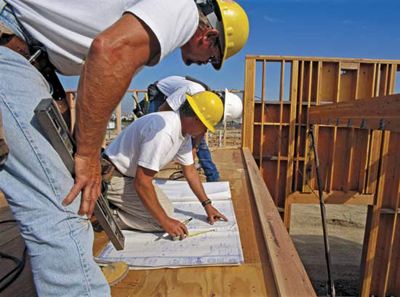PPI stays mild overall but inputs vary; nonres starts stall, CMD says; housing starts leap
 Editor’s note: Construction Citizen is proud to partner with AGC America to bring you AGC Chief Economist Ken Simonson's Data DIGest. Check back each week to get Ken's expert analysis of what's happening in our industry.
Editor’s note: Construction Citizen is proud to partner with AGC America to bring you AGC Chief Economist Ken Simonson's Data DIGest. Check back each week to get Ken's expert analysis of what's happening in our industry.
The producer price index (PPI) for final demand increased 0.5%, not seasonally adjusted (0.4%, seasonally adjusted), in June but declined 0.7% over 12 months, the Bureau of Labor Statistics (BLS) reported today. AGC posted tables and an explanation focusing on construction prices and costs. Final demand includes goods, services and five types of nonresidential buildings that BLS says make up 34% of total construction. The PPI for final demand construction, not seasonally adjusted, rose 0.1% in June and 1.8% over 12 months. The overall PPI for new nonresidential building construction—a measure of the price that contractors say they would charge to build a fixed set of five categories of buildings—climbed 1.7% since June 2014. The 12-month increases ranged from 0.8% for healthcare construction to 1.6% for schools, 1.7% for warehouses and industrial buildings, and 2.2% for offices. PPIs for new, repair and maintenance work on nonresidential buildings by plumbing contractors rose 0.2% over 12 months; roofing contractors, 2.3%; electrical contractors, 2.7%; and concrete contractors, 3.4%. An expanded set of PPIs for inputs to construction, excluding capital investment, labor and imports, adds services to the previous PPI for construction industries, goods (formerly called inputs to construction industries). Goods constitute 60% of the index (including 7% for energy); services, 40% (trade services, 25%; transportation and warehousing services, 4%; other services, 10%). The overall PPI for inputs to construction increased 0.1% from May to June, as the index for energy climbed 2.3% for the month, outweighing a drop of 0.1% in the index for goods less food and energy and a flat services PPI. The PPI for all goods used in construction declined 2.8% over 12 months. Materials important to construction that had notable one- or 12-month price changes include diesel, down 1.8% for the month and 35% over 12 months; steel mill products, -1.0% and -12%, respectively; lumber and plywood, -0.5% and -7.0%; paving mixtures and blocks, -0.6% and 4.1%; flat glass, 2.8% and 4.0%; concrete products, -0.2% and 4.2%; and cement, -0.4% and 7.1%.
The value of nonresidential construction starts, not seasonally adjusted, decreased 4.8% from June 2014 to June 2015 and 1.0% year-to-date for the first half of each year, CMD (formerly Reed Construction Data) reported on Thursday, based on data it collected. Nonresidential building starts declined 7% over both intervals. Institutional building starts climbed 2.6% year-over-year in June but slumped 13% year-to-date. Commercial building starts skidded 2.2% and 9.4%, respectively. Heavy engineering starts slipped 1.1% year-over-year but jumped 10% year-to-date.
Housing starts leaped 27% from June 2014 to June 2015 and 11% year-to-date, the Census Bureau reported Friday. Single-family starts increased 15% year-over-year and 9.1% year-to-date, and multifamily (buildings with 5 or more units) starts rose 55% and 15%, respectively. Building permits, a fairly reliable predictor over time of near-term starts, especially single-family, soared 30% year-over-year and 16% year-to-date overall, with single-family permits rising 6.0% and 8.6%, respectively, and multifamily up 79% and 29%. Multifamily permits year-to-date (234,000) far exceed starts (182,000), suggesting more projects may begin soon. Single-family permits year-to-date (343,000) virtually match starts (345,000).
"All 12 Federal Reserve districts indicated that economic activity expanded from mid-May through June," the Fed reported on Wednesday in its latest "Beige Book," a compilation of informal soundings of business conditions in each district (which is referenced by the name of its headquarters city). "Reports on residential construction activity varied by district. Richmond, St. Louis and Minneapolis indicated that activity was mixed. Cleveland reported that single-family starts picked up across most of the district; Atlanta noted that construction was up from the year-ago level, and Kansas City indicated that residential construction expanded....Philadelphia and Cleveland indicated that nonresidential construction activity continued at its previous pace, while other districts, such as Richmond, Atlanta, Chicago, St. Louis, Minneapolis [and] Kansas City, noted an increased level of nonresidential construction activity. Multifamily construction was described as strong, elevated, robust, and picking up by several districts, including New York, Richmond, Atlanta, Dallas and San Francisco. Commercial real estate outlooks remained fairly favorable. Philadelphia was generally optimistic, Atlanta remained positive; Kansas City expected strengthening in the months ahead; and Dallas remained cautiously optimistic....Boston's report noted low interest rates and generous terms for commercial real estate mortgages and construction loans....Firms from several districts continued to describe shortages for particular types of skilled labor, predominantly in the construction industry. Wage pressures were modest across most areas of the country, outside of some specialized skill and high-demand occupations in sectors such as information technology, transportation and construction."
"More than 30 refining expansions worth $14 billion total are under development across the United States as the industry hustles to take advantage of the oil glut, according to a new analysis by Petrochemical Update, which analyzes construction trends for the industry," the Houston Chronicle's FuelFix blog reported on July 9. "But the industry has a shortage of workers with experience managing such massive investments, which can make it difficult for companies to accurately estimate how much a project will cost and how long it will take to build, the report said. 'The industry is suffering from a depleting resource pool of highly experienced project managers and project support personnel,' Stephen Cabano, president of Pathfinder, a project management consulting firm, wrote in the report."
The Data DIGest is a weekly summary of economic news; items most relevant to construction are in italics. All rights reserved. Sign up at http://store.agc.org.


